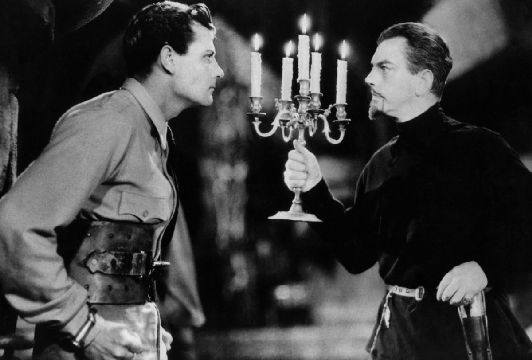The Most Dangerous Game (1932) 

Director: Irving Pichel, Ernest B. Schoedsack
Cast: Joel McCrea, Fay Wray, Leslie Banks
Synopsis: An insane hunter arranges for a ship to be wrecked on an island where he can indulge in some sort of hunting and killing of the passengers.
‘The world’s divided into two kinds of people: the hunter and the hunted. Luckily I’m the hunter. Nothing can change that.’ So says cocky white hunter Bob Rainsford (Joel McCrea) in response to the philosophising of a fellow cabin cruiser passenger who reflects that ‘the beast of the jungle, killing just for his existence, is called savage. The man, killing just for sport, is called civilized.’ Those words no doubt come back to haunt hunter Bob when he’s one of three survivors after the cruiser crashes on rocks. The other two survivors are quickly claimed by sharks — ‘argh! It’s got me!’ exclaims the ship’s captain before going under — who, in light of later revelations, probably hang around the area just waiting for ships to pass by, but Bob manages to make it to shore, and after wondering through a jungle he comes across an old fortress.
It’s the home of Count Zaroff (Leslie Banks), one of cinema’s greatest mad noblemen. Zaroff is a former member of the Russian aristocracy who escaped his homeland with most of his fortune intact and made his home in this remote castle. Banks’ performance, while as hammy as you might expect from a hissable early talkie villain, is strengthened by the disfiguring scars he received from injuries during service in the First World War. Zaroff is one of those mad men whose insanity is concealed by a deceptively urbane exterior, although anybody who employs a hulking mute doorman named Ivan (Noble Johnson) has to be immediately suspect.
To be fair to Rainsford, he’s pretty quick to figure out that something’s not quite right about the Count and his minions, and his suspicions are strengthened that same evening when he meets the Count’s other guests, Martin (Robert Armstrong) and Eve (Fay Wray), a brother and sister who are also survivors of a shipwreck. Martin isn’t shy about helping himself to the Count’s hospitality and is very quickly three sheets to the wind, while Eve tries in vain to deliver a coded warning about danger to Rainsford. Later, while the Count entertains his guests with a tune on the piano at Martin’s drunken bidding, Eve surreptitiously clues Rainsford in on her suspicions. She informs him that there were originally four survivors, but that two of them have mysteriously disappeared. With this in mind, you’d think she’d be a bit nervous about how badly her drunken brother seems to be irritating the Count — in fact, you’d think she might have voiced her suspicions to her brother at some point. But Martin seems as happy as a drunk with an endless supply of booze and a breezy incomprehension of just how annoying his drunken camaraderie really is, and Eve is happy enough to leave him with the Count as she toodles off to bed.
Later that night though, she comes to Rainsford’s room, worried that Martin hasn’t returned to his. The pair of them descend the steps of the darkened castle and into the vaults where they find some grisly hunting trophies mounted on the walls. And while they’re rooting around down there, the Count and his men show up with his latest kill. You don’t need this reviewer to tell you who Zaroff’s latest victim is, and the discovery causes Eve to foolishly give up her hiding place to berate the Count. Zaroff has her escorted away and confesses his dastardly game to Rainsford. He deliberately moved the light buoys at sea so that ships would crash, providing him with a regular supply of survivors to act as his prey. All they have to do is stay alive for one night in the jungle to earn their freedom. Needless to say, Rainsford is to be the next player in Zaroff’s nasty little game.
The Most Dangerous Game is barely more than an hour long, and therefore paints its characters in broad strokes. They each pretty much define themselves in a few sentences before moving on with the storyline, which is all build up to the concluding hunt. There’s a nice menacing atmosphere to it though, and Zaroff’s castle — ‘built by the Portuguese’ — looks terrific. While Zaroff might not exactly be an imposing madman, he nevertheless possesses an unshakable confidence about his right to hunt down and kill other human beings like animals. Other filmmakers might have dwelt more upon the notion of why it’s considered ok to hunt animals but not humans for sport but directors Irving Pichel and Ernest B. Schoedsack are more intent on delivering a visceral thrill than pondering the moral and philosophical aspects of the tale. And let’s face it, most of us are, too. While the movie is entertaining enough prior to the hunt it elevates itself to another level once it begins. The Most Dangerous Game might appear creaky and outdated these days, but it has served as the inspiration for countless movies in the eighty-odd years since it was first released.
(Reviewed 7th September 2013)
httpv://www.youtube.com/watch?v=V9tG2iUl3j4
